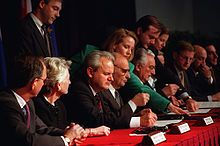“Punting the Pundits” is an Open Thread. It is a selection of editorials and opinions from around the news medium and the internet blogs. The intent is to provide a forum for your reactions and opinions, not just to the opinions presented, but to what ever you find important.
Thanks to ek hornbeck, click on the link and you can access all the past “Punting the Pundits”.
Follow us on Twitter @StarsHollowGzt
Since the release of the summary of the Senate’s Torture Report, the torture apologists have been out in force calling the report inaccurate and misleading, and repeating long debunked lies about the accuracy of the intelligence. Chief among them this week will be former Vice President Richard Bruce Cheney who will be Chuck Todd’s guest on this morning’s “Meet the Press“. The Intercept‘s Dan Froomkin has some suggestions for [questions Chuck might want to ask Dick instead of the usual “MTP” treatment of rolling over and playing dead at the feet of the contentious war criminal.
Of all the questions proposed, my favorites are the one Chuck asked Glenn Greenwald:
and this one that Dan had proposed Cheney be asked in 2011:
“Just how much had you had to drink before you shot your friend in the face?
Dick Cheney Will Eat Chuck Todd For Breakfast Unless Todd Does Exactly What I Say
When Cheney was vice president, his chief M.O. was to spread false information and savage his critics, while avoiding any sustained inquisition. He often did that through intermediaries.
But when he needed to take things into his own hands, “Meet the Press” was “best” because, while there might be a tough prepared question or two, then-host Tim Russert could be counted on to follow up obsequiously or not at all, without in any way knocking the veep off his talking points. [..]
But I have some ideas about what Todd could do differently. (And so did several of my Twitter followers.)
The key is quite simple: Instead of asking Cheney for his reaction to the report, Todd should use the opportunity to ask Cheney factual questions, to fill in gaps in the record. [..]
Q. Why did people within the CIA start talking about torture, when historically their view was, as Senator Feinstein mentioned in her speech on Tuesday, that “inhumane physical or psychological techniques are counterproductive because they do not produce intelligence and will probably result in false answers”?
Q. Do you know who first came up with the idea of using torture as part of the interrogation of detainees?
Q. What was the first time you heard anything about making interrogation tactics more brutal?
Q. When was the first time you heard about waterboarding? What was your reaction?
Q. How often were you or your office in touch with the CIA in late 2002 and early 2003 about interrogation matters?
Q. Describe your chief counsel David Addington’s involvement in developing interrogation policy.
Q. What was the first report you heard that made you think torture was “working”?
Q. What do you consider torture? [..]
Q. Do you have any reason to dispute the report’s description of “rectal feeding” and “rectal hydration”? Had you heard anything about this before? Does that sound OK to you?
Q. Did you watch any of the videos of detainees being interrogated at the black sites ? What was that like for you?
Q. Did you ever speak directly to someone involved in administering those interrogation tactics? What was that like? [..]
Q. A 2008 Senate Armed Services Committee report concluded that you bore direct responsibility for what happened at Abu Ghraib and elsewhere. Didn’t you notice that the interrogation tactics you architected for CIA use had migrated into the military?
Q. Did you ever suggest to anyone that any specific interrogation practice be stopped?
Q. Do you think it’s likely that some of these tactics will be returned to use in the future?
Q. How would you feel if an American were subject to this kind of interrogation? How would you want the country to respond?
Q. Do you plan to travel to Europe?
The Sunday Talking Heads:
This Week with George Stephanopolis: This Sunday’s guests are former CIA Director Gen. Michael Hayden; Army veteran Eric Fair; and New York Times columnist Tom Friedman.
The roundtable guests are: Rep. Keith Ellison (D-MM); former House Speaker Newt Gingrich; syndicated radio host Laura Ingraham: and CNN & SiriusXM host Michael Smerconish.
Face the Nation with Bob Schieffer: Mr. Schhieffer’s guests are: Sen. Saxby Chambliss (R-GA); Sen. Angus King (I-MA); Rep. Mike Rogers (R-MI); and Sen. John McCain (R-AZ).
His panel guests are Peggy Noonan, Wall Street Journal; Michael Gerson, Washington Post; Charles Ellison, The Root; and Mark Mazzetti, The New York Times.
Meet the Press with Chuck Todd: This Sunday’s “MTP” guests are: Vice President Dick Cheney and Sen. Ron Wyden (D-OR).
Hopefully by now Dick will have read the report. The panel guests are a mystery. I love a mystery.
State of the Union with Candy Crowley:
Nest week will be Ms. Crowley’s final appearance as host. She announced her resignation from CNN last week.
Ms. Crowley’s guests are: Rep. Peter King (R-NY); and Gov. Deval Patrick (D-MA).
Plus, part two of Candy Crowley’s exclusive interview with President George W. Bush.

 On this day in 1995,
On this day in 1995, 

 On this day in 1642,
On this day in 1642,  New Zealand is one of the most recently settled major landmasses. The first known settlers were Eastern Polynesians who, according to most researchers, arrived by canoe in about AD 1250-1300. Some researchers have suggested an earlier wave of arrivals dating to as early as AD 50-150; these people then either died out or left the islands. Over the following centuries these settlers developed into a distinct culture now known as Maori. The population was divided into iwi (tribes) and hapu (subtribes) which would cooperate, compete and sometimes fight with each other. At some point a group of Maori migrated to the Chatham Islands where they developed their distinct Moriori culture.
New Zealand is one of the most recently settled major landmasses. The first known settlers were Eastern Polynesians who, according to most researchers, arrived by canoe in about AD 1250-1300. Some researchers have suggested an earlier wave of arrivals dating to as early as AD 50-150; these people then either died out or left the islands. Over the following centuries these settlers developed into a distinct culture now known as Maori. The population was divided into iwi (tribes) and hapu (subtribes) which would cooperate, compete and sometimes fight with each other. At some point a group of Maori migrated to the Chatham Islands where they developed their distinct Moriori culture.
